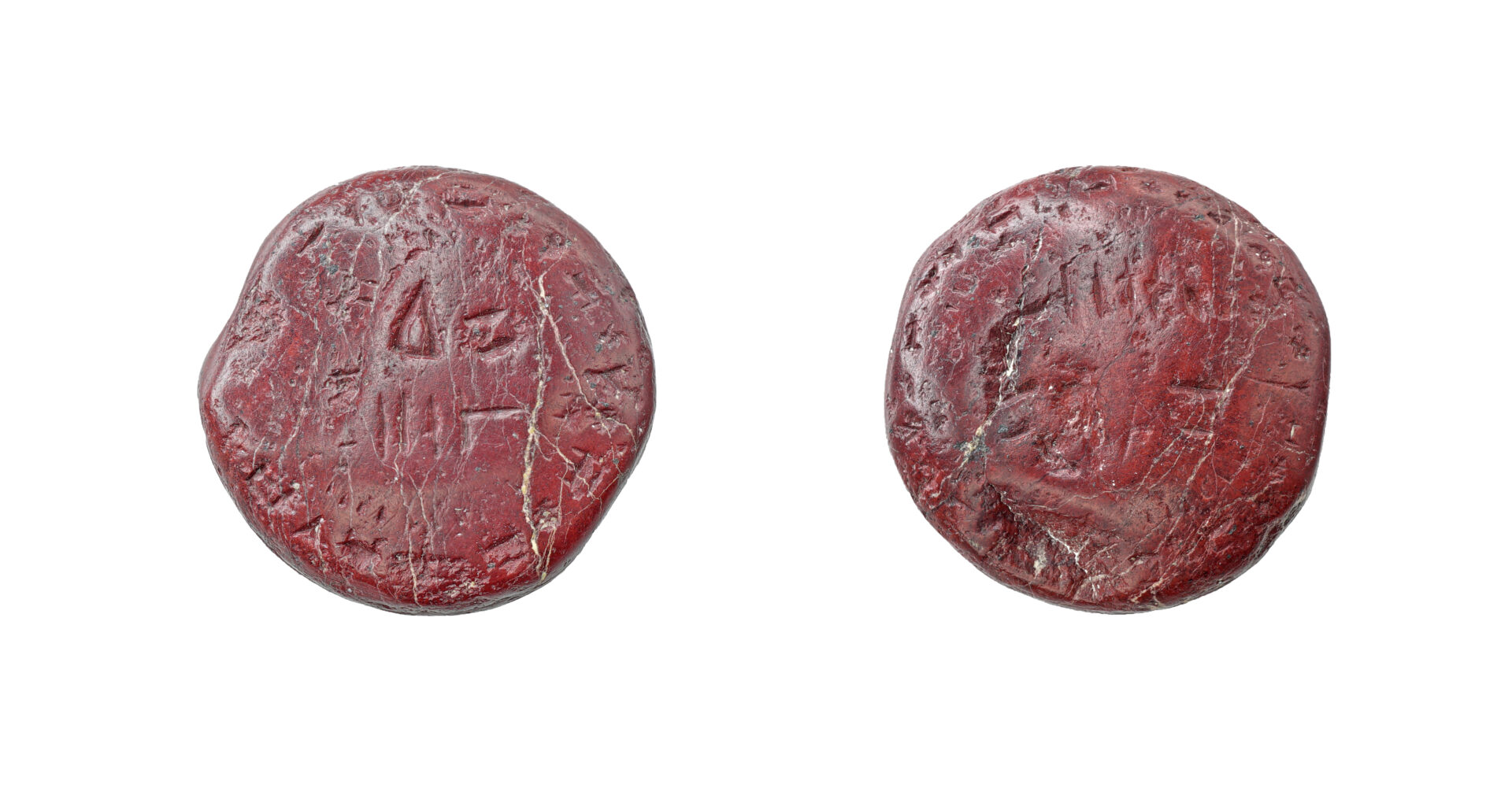Exhibit of the month
Amulets for children
Inscribed hematite amulet
National Archaeological Museum
Collection of Prehistoric Antiquities, inv. no. P 8184
Origin: Perati Attica, cemetery of chamber tombs, Tomb 24
Dimensions: Diameter: 2.6 cm.
Date: beginning of 12th c. BC.
Exhibition Place: Exhibition of Mycenaean Antiquities, Gallery 3, Showcase m3.
On the eastern coast of Attica, specifically at Perati site near Porto Rafti, extensive excavations have uncovered a sizable cemetery comprised of chamber tombs dating back to the 12th century BC. This period coincides with the aftermath of the destruction of the Mycenaean palaces. This cemetery is attributed to a prosperous community of merchants and sailors who maintained vibrant trade relations and connections with various regions, including Crete, the Dodecanese islands, the Cyclades, Cyprus, the coast of Asia Minor, and the shores of the Levant
One of the earliest graves unearthed within this cemetery contained the remains of a child. Remarkably, this child was adorned with a necklace of glass, faience, and rock crystal beads. The necklace featured an inscribed amulet fashioned from hematite stone, along with a sealstone. The burial also included two small clay vases, an ivory comb, and a goat’s horn, which the excavator interpreted as an amulet—constituting a comprehensive assortment of funerary gifts for the departed individual.
The inscribed amulet, imported from Cyprus but inspired by Hittite patterns, is crafted from red hematite. It bears inscriptions on both sides featuring variations of Linear A or B signs, cypro-minoan script, and Luwian hieroglyphics[1]. However, these inscriptions do not form coherent words or hold any discernible meaning. It appears that the amulet was created by an illiterate artisan who attempted to mimic writing symbols and objects that were familiar to him. The presence of wear on the hanging hole, indicative of the thread or leather that once suspended it, as well as on the incised surfaces, suggests that the amulet had been in use for many years prior to its placement in the tomb and may have been a family heirloom.
Within the Perati cemetery, several other amulets are also discovered, belonging to the magico-religious traditions of Egypt and the Levant. Some of these amulets are associated with the safeguarding of children, mothers, and childbirth, like two miniature faience figurines depicting Egyptian deities Bes and Taweret[2] and two golden crescent-shaped pendants[3].
The remarkably high child mortality rate in ancient times gave rise to metaphysical interpretations, revolved around the belief that both malevolent and benevolent demonic beings and deities had the power to either inflict harm or provide protection against diseases and premature death for the vulnerable yet precious young members of society. Amulets, available in diverse forms, and crafted from various materials, whether precious or of lesser value, played a crucial role in attracting the benevolent influence of deities and warding off malevolent forces.
This ancient practice has endured through the ages, as evidenced by contemporary customs. Even today in Greece, close relatives often present newborns with amulets such as the “blue eye” amulet and miniature crosses, as a means of offering protection and blessings.
[1] Luwian hieroglyphic is a writing system attested in Anatolia and Syria between the 14th and the 7th century B.C.
[2]The demon-god Bes, depicted as a misshapen short man with a lion’s tail and sometimes a crown, was a particularly beloved figure in the Egyptian pantheon. Together with the also popular goddess Taweret who was depicted as a female hippopotamus with a crocodile’s back, they were protectors of pregnant and lactating women, childbirth and children.
[3]Gold pendants in the shape of a crescent, are already known in Egypt and the Levant during the second half of the 2nd millennium BC. and are considered amulets against witchcraft, while until late antiquity they are related to the protection of children. One of the two gold crescents from Perati was found around the neck of an adult and the second in a children’s grave.
Katerina Kostanti
Bibliography
Iakovides, Sp., Περατή. Το Νεκροταφείον, Βιβλιοθήκη της Εν Αθήναις Αρχαιολογικής Εταιρείας αρ. 67, Athens 1969-1970.
Kostanti, K., «Μηνοειδή περίαπτα στο προϊστορικό Αιγαίο», in Viglaki, P et al. (eds.), Αελόππος. Τιμητικός τόμος για την Ίριδα Τζαχίλη, Τα Πράγματα, Athens 2023, 344-257.
Merkouri Ch., «‘Φυλακτήριον εκκρέμαται τοις παιδίοις’. Οι μαρτυρίες των χοών», στο Χ. Μερκούρη (επιμ.), Βάσκανος Οφθαλμός. Σύμβολα μαγείας από ιδιωτικές αρχαιολογικές συλλογές, Υπουργείο Πολιτισμού και Τουρισμού – Εφορεία Αρχαιοπωλείων και Ιδιωτικών Αρχαιολογικών Συλλογών, Αθήνα 2010, σ. 77-86, Athens 2010, pp. 77-86.
Andrews C.,Amulets of Ancient Egypt, University of Texas Press, Austin 1998.
Dasen V., “Les amulettes d’enfants dans le monde greco-romain”, Latomus62/2 (2003), pp. 275-289.
Loeben, CE, “Taweret and Bes. A demonic goddess and a divine demon?”, in T. Bagh & L. Manniche (eds), Bes. Demon God Protector of Egypt, Ny Carlsberg Glyptotek, Copenhagen 2021, 73-81.


